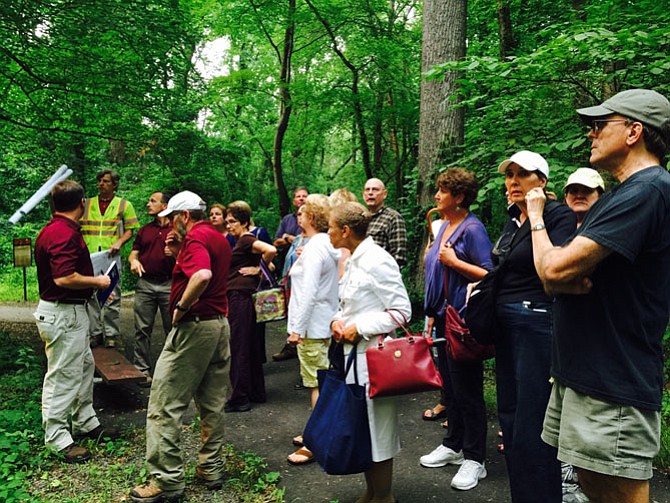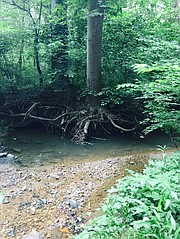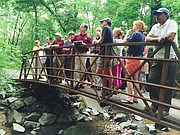Residents raised concerns about losing more than 200 trees in McLean Central Park as part of restoration of Dead Run stream. Photo by Ken Moore.
Many McLean Central Park neighbors aren’t convinced. Why focus on McLean Central Park, asked one resident, “in this pleasant community where people don’t want to be disturbed?”
Last Tuesday, June 9, more than 75 people attended a community meeting at Dolley Madison Library where members of the Department of Public Works gave updates to a Dead Run Stream Restoration Project they hope to begin selecting contractors for in the fall of 2016.
“There’s a real reason why we are here. There’s real degradation,” said Matt Meyers, Watershed Projects Implementation Branch Chief for Fairfax County Stormwater Planning Division. “We know that this is an important project to improve the quality of the stream. We want to work with you to make it a good project.”
Meyers and other team members took about two dozen residents outside to walk along Dead Run Stream behind the Dolley Madison Library and Community Center to demonstrate why restoration is needed and to let residents ask more questions in the field where the impact would be visible.
Dead Run is impaired and in poor quality, he said.
Meyers highlighted the intensity of stream erosion and degradation, increasing phosphorous levels and flooding that is impacting the surrounding community. The stream restoration project would improve water quality by reducing sediment and nutrient loads, stabilize stream banks to reduce bank erosion and reduce tree loss in the future, improve aquatic habitat and restore and enhance the stream buffer, officials said.
Slides were shown of Reston’s Snakeden Branch, where stream restoration efforts appear successful.
Get Involved
The county wants to start a task force in July, called the “Stream Team,” through Supervisor John Foust’s office.
The Department of Public Works intends to invite anyone who is interested to be involved in the Stream Team throughout the duration of the project in order to voice concerns of the neighborhood and community and to voice concerns and questions.
Contact Ben Wiles in the office of Supervisor Foust at 703-356-0551.
Send Comments
Comments on current plans should be directed to the project manager Dipmani Kumar at dkumar@fairfaxcount… or 703-324-5500.
NEIGHBORS VOICED ANGER over lack of outreach at the beginning of the project, lack of warning of the 220 trees that could be destroyed, impact on individual homes and yards, lack of assurance that the project will be successful, loss of noise buffers from trees and more.
Meyers admitted the county’s efforts to include the community at the beginning of the project were less than optimal. “We know we got off to a bad start,” said Meyers.
Through Supervisor Foust’s office, the county hopes to develop a “Stream Team,” a task force of interested and concerned citizens who can voice concerns of the community and help develop a project that meets goals of both the stream and the public.
“We’re taking a step back,” said Meyers, “slowing down to work with the community. We know it’s an important park but we also want to improve the health of the stream.”
While Ben Wiles of Supervisor John Foust’s office suggested a task force with about 10 members could be most effective, he also said they are prepared to include anyone who wants to be involved in the Stream Team.
“We can certainly accommodate anybody who is interested,” he said. “We’d like to have people who want to stay involved in the entire project.”
The County started to address some community concerns last week, although some concerns were put to rest.
For example, neighbors were concerned that trails inside McLean Central Park would be closed for up to a year. “This is inaccurate,” said Dipmani Kumar, project manager.
But the county did confirm that there would be loss of trees, including the loss of 88 trees greater than 12 inches in diameter (23 already at risk), 133 6-12-inch trees (up to 20 for access) and 28 which are at risk.
“The estimated canopy loss is approximately 11 percent of the forest area,” said Meyers.
He and his colleagues said 20 percent of the trees were at risk already, a percentage neighbors disputed.
THE COUNTY acknowledged it needs to improve outreach efforts and will work with the park authority to improve its notification process to alert residents of timetables and future community meetings.
“We recognize that our standard public notification process was inadequate,” read county documents.
Neighbors hope smaller equipment can be used in the project to minimize impacts as well as other considerations.
Bob Vickers, tree commissioner, asked if there were alternative design plans to reduce the number of trees to be cut down, if smaller equipment could be used, and if property owners could allow access to minimize impact.
The county said such conditions could be mandated as special conditions in bid documents, but limitations on equipment could mean fewer bidders would submit applications to work on the project, and timelines might be extended and be more costly.
Dead Run Time Line
Fall 2013: Project initiated
Winter 2013: Surveys and assessment completed
April 23, 2014: First public meeting
Aug. 15, 2014: Field walk with park authority, McLean Trees Association and Urban Forestry
February 2015: Pre-concept revisions made after vociferous response to proposed tree loss
Feb. 18, 2015: Second public meeting
May 12, 2015: Revised concept plan with alternative access options completed
June 9, 2015: About 75 people attend community meeting and offered opportunity to engage in second field walk
June 30: Comments on the current concept plan gathered.
July: “Stream Team,” a task force of interested citizens and residents, scheduled to start meeting in early July.
August: Department of Public Works hopes to develop final concept plan to publish on its website with assistance from the Stream Team
September: Present final concept plan in a community meeting
December: Develop 95 percent design plans.
Early 2016: Present final design phase in community meeting
Summer 2016: Final plan authorization and bidding phase (based on funding and approved budget)
A final “Pardon Our Dust” meeting with residents and the contractor will be scheduled before construction notices to proceed are implemented.



